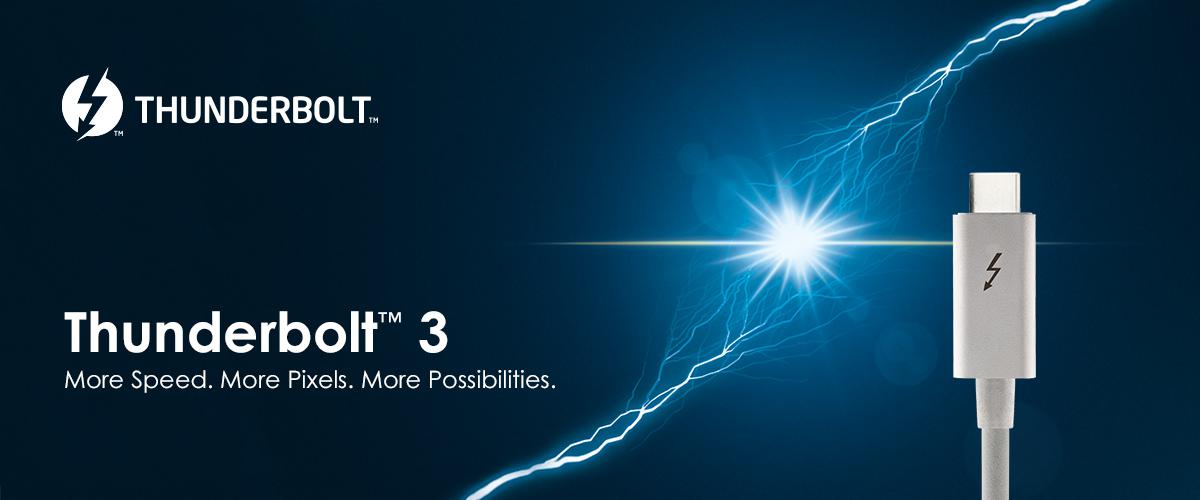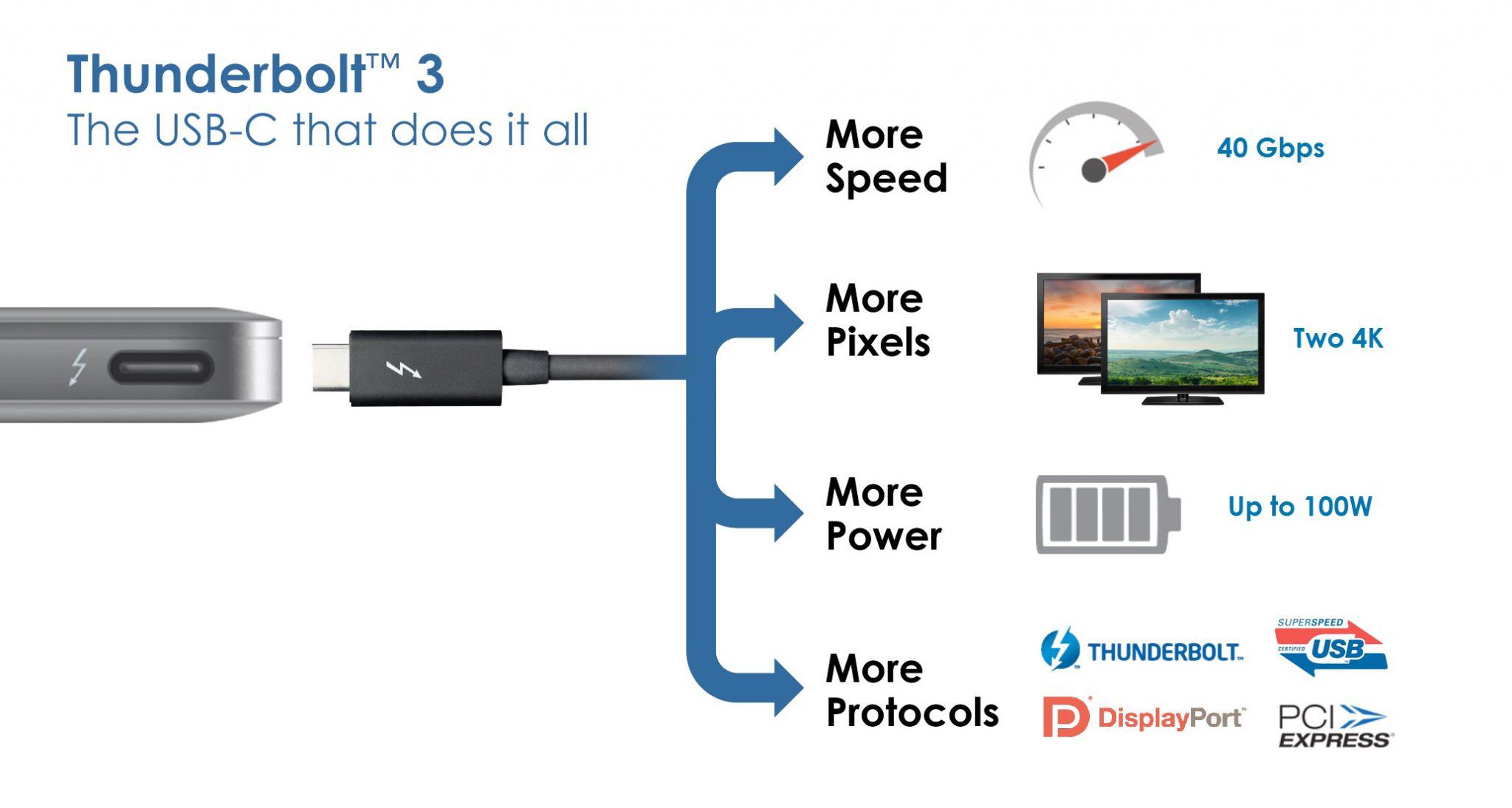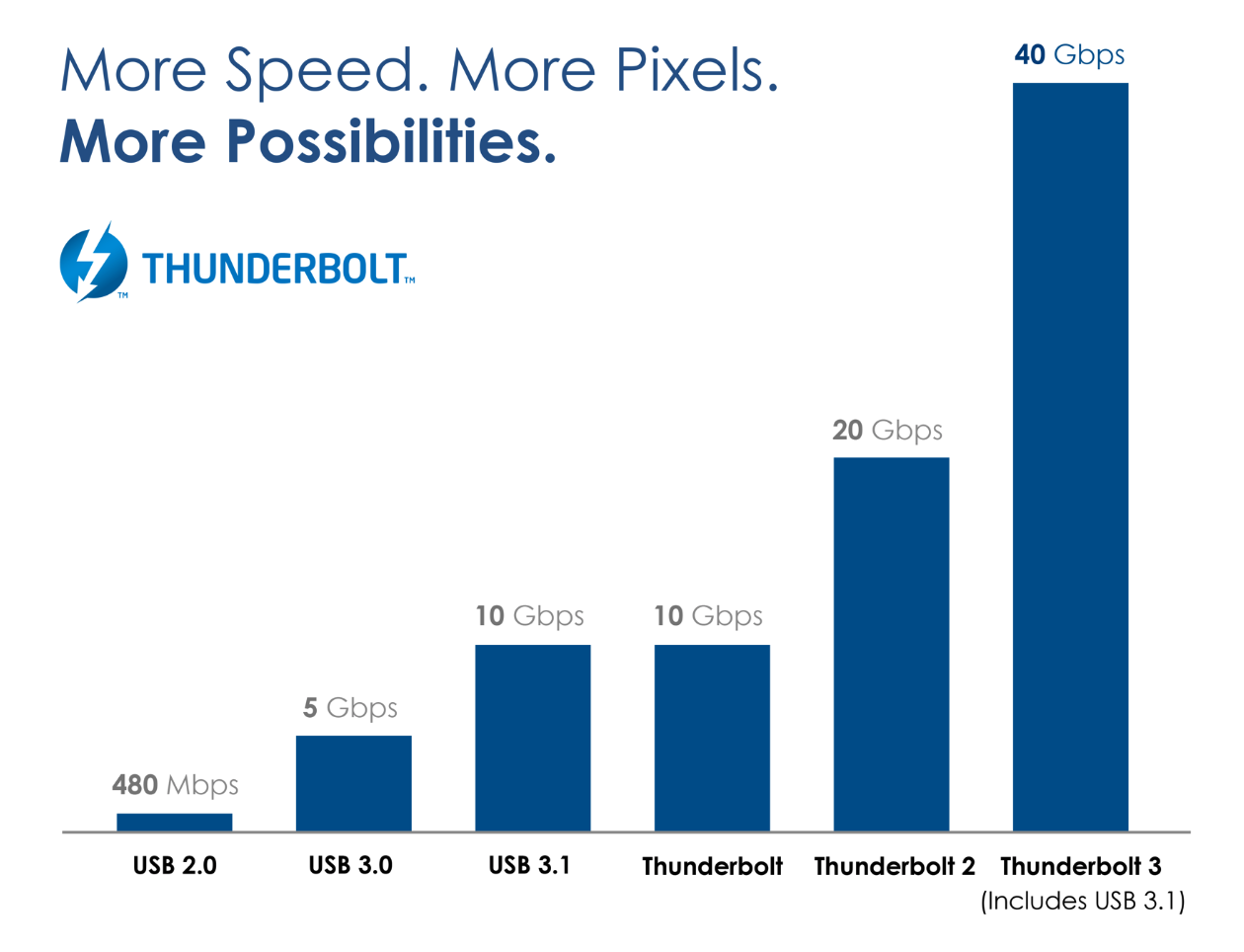Considering the performance of the omnipresent USB 3.0 and 3.1 serial bus standards, Thunderbolt 3 still fares much better. USB 3.0 features a data transfer rate of up to 5 Gb/sec, while 3.1 takes that up to 10 Gb/sec, still four times less than what Thunderbolt 3 can do. The most recent USB 3.2 Gen 2×2 is another incremental improvement, sporting 20 Gbps of bandwidth, still far behind Thunderbolt’s 40 Gbps. USB 3.0 can deliver power transmissions of a maximum of 7.5 watts, while USB 3.1 and above support up to 100 watts–enough to charge most laptops–using a new standard known as USB Power Delivery, or “USB PD”.
USB4 is the only specification that can compete with Thunderbolt 3, and the reason for this is that USB4 is actually based on Thunderbolt 3. Intel decided to make the Thunderbolt 3 a royalty-free standard to OEMs and hardware manufacturers, and they released its specifications in 2018. A year later, USB4 was released by the USB Implementers Forum (USB-IF). And while the specs for USB4 and Thunderbolt 3 may look the same, Thunderbolt 3 always carries PCI Express (PCIe) signaling, whereas with USB4 it’s up to the manufacturer whether to support PCIe traffic. As a result, USB4 hosts, depending on their design, may or may not support Thunderbolt devices.
Thunderbolt 3 Compatibility with Other Standards
In terms of compatibility with other standards and protocols, Thunderbolt 3 is backward compatible with the previous two generations as long as an adapter is used since the ports are different. As for the USB protocol, Thunderbolt 3 can work with USB 2.0, 3.0, 3.1 Gen 2, 3.2, and, in some cases, USB4. Of course, the speeds are limited to the quickest protocol that is supported by the connecting cable, and the quickest protocol supported by the connected device. For example, a USB 3.0 stick connecting to a Thunderbolt 3 USB-C port will work on USB 3.0 speeds.
What Devices Support Thunderbolt 3?
Being the creation of Apple and Intel, the devices of both of these manufacturers have been supporting Thunderbolt 3 since December 2015. That said, the Apple MacBook Pro of 2016 features two or four Thunderbolt 3 ports (depending on the model), while the iMac line that was refreshed in the summer of 2017 also includes two Thunderbolt 3 ports. The iMac Pro which was released later, in December 2017, offers a comfortable four Thunderbolt 3 ports. Until today, Thunderbolt 3 remains (mostly) the de facto standard for the connectivity ports of Apple products, so even the most recent, 2019 16-inch MacBook Pro is equipped with four Thunderbolt 3 ports. There are exceptions among the Apple line, so please check your specific model to see if it is one of the few models that does not have Thunderbolt 3 ports. Intel’s products like the “NUC” computers released since 2015 are compatible with the standard and have at least one Thunderbolt 3 port.
When it was announced that Thunderbolt 3 was to become royalty-free, other manufacturers besides Apple and Intel didn’t hesitate to adopt it on their products. At this time there also weren’t any alternatives that could compete with it. In addition, Thunderbolt 3 enabled laptop manufacturers to make their products thinner. Acer, Asus, Clevo, HP, Dell, Dell Alienware, Lenovo, MSI, Razer, and Sony all released notebooks that supported Thunderbolt 3 almost immediately, while Gigabyte rushed to throw the first Thunderbolt 3 motherboard in the market as well.
Naturally, we have gone a long way since 2015, and today there are hundreds of products that support Thunderbolt 3, and many types of hardware manufacturers who have adopted it as well. There are notebooks, laptops, computers, storage devices, motherboards, docks, eGFX units, cables, camera/surveillance storage devices, add-in-cards, displays, docks of all kinds, adapters, expansion interfaces, and more.
Because both the USB and the Thunderbolt 3 standards use the same USB-C port, it can be confusing as to which of the two is supported by a specific product. If you don’t have access to the vendor’s technical specifications look for the characteristic Thunderbolt 3 symbol, a small lightning symbol. If you don’t see it then it’s a USB port.
Will Thunderbolt 3 Be Compatible with Devices in the Future?
The big question you may be asking: is Thunderbolt 3 future-proof, and up to what point?
By making the standard royalty-free and releasing the technical specifications for it in 2018, Intel has laid the groundwork for boosted adoption rates. USB4 is coming as a confirmation of this, and while Thunderbolt didn’t manage to dethrone the USB standard all these years, it is good to see the potential for increased compatibility. However, this will actually come down to whether or not the USB4 manufacturer uses PCIe. This missing piece is the difference between whether or not two products will even be compatible.
Intel refreshed Thunderbolt 3 to bump the support from DisplayPort 1.2 up to 1.4, but unfortunately chose not to support this standard on Macs, even though the hardware is capable of it. Devices with support for DisplayPort 1.4 will see maximum video resolutions increase from 4K at 60Hz to 8K at the same refresh rate, plus HDR. Also in version 1.4, 4K video can reach up to 120 Hz. With Thunderbolt 3 already prepared for a continual climb in the video resolutions and refresh rates preferred by consumers its position as the standard is fairly secure for the next few years.
Thunderbolt 4 was confirmed by Intel during its CES 2020 presentation. There’s not much known about the upcoming fourth generation of Thunderbolt, other than the fact that it’s going to have the same bandwidth as the previous version, and may be based on PCI Express 4.0. It is suspected that Intel will attempt to maintain compatibility with Thunderbolt 3, USB4, and USB 3.x. With Thunderbolt 4 expected to hit the market together with USB4, a new wave of devices is going to take over larger chunks of the market share, so Thunderbolt 3 will become even more relevant.
If you’re wondering whether or not you should skip the Thunderbolt 3 offerings and wait for USB4 or Thunderbolt 4 devices, you shouldn’t be. Thunderbolt 3 is well positioned to hold onto its lead as a connectivity standard. It continues to win the speed race at 40 Gbps alongside USB4 and Thunderbolt 4, and with its minimal compatibility hurdles it may well remain in this position for a few years. There continues to be some confusion over USB-C and Thunderbolt 3, and some manufacturers even contribute to this. And while the benefits outweigh the hurdles when it comes to Thunderbolt 3, take our tech team’s advice and do your homework before you buy.





Loading Comments